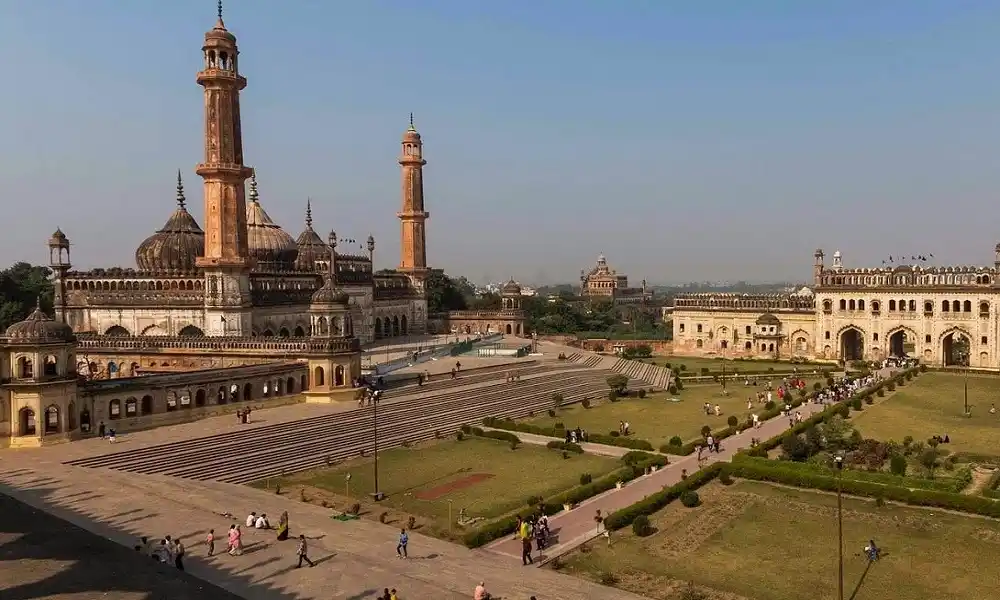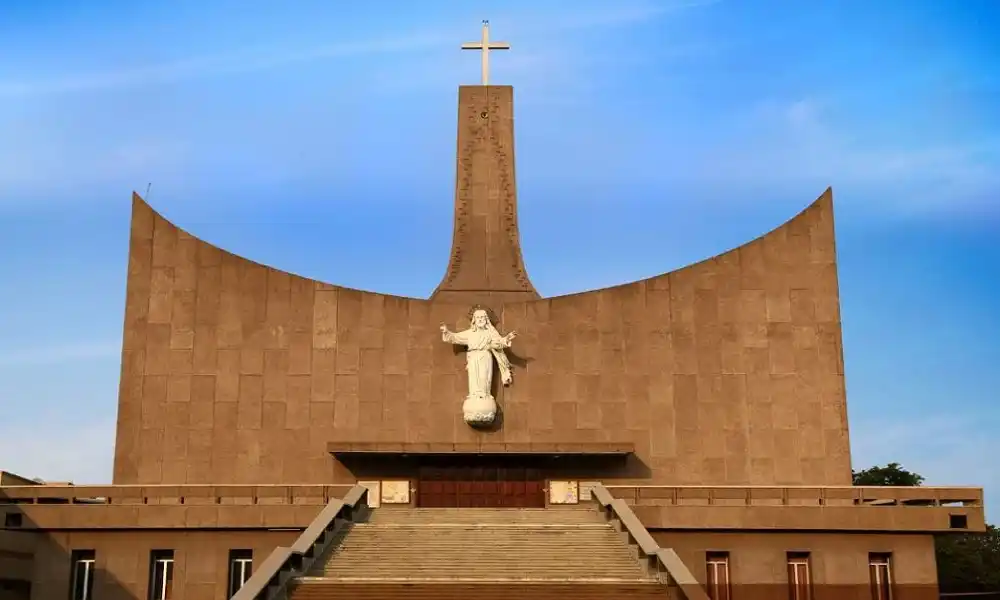Last Updated on 22/04/2025
- Country: India
- State: Uttar Pradesh
- District: Lucknow
- Area: 2,528 square kilometres (metro)
- Elevation: 128 m
- Population: 3 million
- Pin code: 226
- Telephone Code: 0522
- Time Zone: GMT plus 5:30
Lucknow (also known by the names City of the Nawabs, the Golden City of the East, Shiraz-i-Hind, Constantinople of India) is the capital of Uttar Pradesh, the most populous state located in the northern heartland of India. It is one of the ninety Minority Concentrated Districts of India and is famous for its architecture, gardens, music, poetry, and cuisine. It is a popular subject of study for keen students of history and culture. Lucknow is the second-largest city of Uttar Pradesh after Kanpur and is a fast-growing metro city in India.
Historically, Lucknow has been a learning center for Hindi and Urdu literature. The city is famous for its Urdu Shayari (poetry).
History

The city of Lucknow and its adjoining parts in the Awadh region came under the successive rule of the Delhi Sultanate, the Mughals, the Nawabs of Awadh, and the British since the mid-14th century. It was also an important center of action during the Sepoy Mutiny of 1857, as well as the freedom movement against British rule. Till the second decade of the 18th century, Awadh was a part of the Mughal Empire, administered by a governor appointed by the Mughal Emperor in Delhi. Awadh has historically been known as the granary of India and was strategically a key place for controlling the Doab region between the Ganga and Yamuna Rivers.
Awadh remained a strong kingdom until the third Nawab, Shuja-ud-Daula, succumbed to the British in the Battle of Buxar in 1764, while aiding Mir Qasim, the fugitive Nawab of Bengal. Thereafter, the defeated king had to cede parts of his kingdom and pay penalties to the East India Company. The British also appointed a Resident at Awadh and gradually brought it under their strong control. However, they abstained from capturing Awadh directly, as that would have brought them into direct confrontation with the Marathas and the Mughals, even though the latter were in decline. Lucknow came into prominence when it was promoted as the capital of Awadh by Nawab Asaf-ud-Daula. The Awadhi Nawabs made lasting contributions toward the architectural magnificence of the city.
In 1798, the fifth Nawab, Wazir Ali, abdicated, and the British helped Saadat Khan accede to the throne. A puppet king was installed by the British in the form of Saadat Khan, who, by a treaty with the British in 1801, ceded half of Awadh to the British East India Company, making the state virtually a vassal state of the Europeans. All revenues and assets of Awadh were spent behind the British, while the inefficient Awadhi rulers continued with their luxurious and pompous lifestyles. In 1856, the East India Company took military action and annexed Awadh, their long-awaited desire, and placed the kingdom under Sir Henry Lawrence’s command. The Nawab, Wajid Ali Shah, was captured and exiled. Wajid Ali’s minor son was crowned king during the 1857 revolt when Sir Lawrence was killed. Lucknow was besieged as well. However, the British later recaptured Awadh after the rebellion was defeated and placed it under a chief commissioner once again.
In 1901, Lucknow, which had served as the capital of Awadh since 1775, was merged with the United Provinces of Agra and Oudh (Anglicized version of Awadh) and was made the provincial capital in 1920. In 1947, after India gained independence, Lucknow became the capital of Uttar Pradesh, or the erstwhile United Provinces. The city played a historical role during the modern Indian freedom movement. The famous Lucknow Pact of 1916 was signed here, and it had strong connections with the Khilafat Movement. During the Khilafat Movement, Maulana Abdul Bari of Lucknow actively co-operated with Mahatma Gandhi and Maulana Mohammad Ali. The All India Kisan Sabha was formed during the Lucknow session of the Indian National Congress in 1936 to organize and lead peasant grievances against oppressive zamindars, playing an instrumental role in igniting the farmers’ movement in India.
Geography
Lucknow is located in the heart of the Northern Plains and is drained by the Gomti River, which divides it into the Trans-Gomti and Cis-Gomti regions. Lucknow is flanked by Rae Bareli district to the south, Barabanki district to the east, Sitapur and Hardoi districts to the north, and Unnao district to the west. Lucknow is located in seismic zone III.
Climate
The city experiences a hot, sub-tropical climate with high humidity. Winter is dry, extending from November to February, while summer extends from April to June. The monsoon lasts from mid-June to mid-September, with an average rainfall of 1,010 mm. The southwest monsoon winds are primarily responsible for the rains in Lucknow. In winter, the maximum temperature can hover around 21°C, while in summer, temperatures can rise up to 45°C.
Economy/Industries
Public Sector Undertakings
Lucknow is the headquarters of the Small Industries Development Bank of India (SIDBI) and the Pradeshiya Industrial and Investment Corporation of Uttar Pradesh (PICUP). The Confederation of Indian Industry (CII) and the Entrepreneurship Development Institute of India (EDII) also have a presence in Lucknow.
Information Technology:
Big IT firms like Tata Consultancy Services and IBM have a presence here.
Manufacturing units like Hindustan Aeronautics Limited, Eveready Industries, and Tata Motors.
Processing industries like milk production, steel-rolling, and LPG bottling.
Agriculture like sugarcane cultivation. Sugar industries are located close to the sugarcane plantations.
Unique embroidery like Chikan and Lakhnavi Zardosi.
Kite-making, fragrance (attar), handicrafts like pottery, earthen toys, and bone-carving products.
Coaching for competitive examinations.
Banking, including the Reserve Bank of India, Citibank, ABN-AMRO, and others.
Oil companies like Indian Oil Corporation, Hindustan Petroleum, Bharat Petroleum, and others.
Attractions of Lucknow
- Chhota Imambara
- Bara Imambara (or Asafi Imambara)
- Rumi Darwaza
- Hussainabad Clock Tower
- Residency
- Shah Najaf
- Bhul Bhulaiya
- Chattar Manzil
- State Museum
- Shaheed Smarak
- Ambedkar Memorial
- Planetarium
- Lucknow Zoo
- Ramakrishna Math
- Vidhan Sabha building
- Charbagh Railway Station
- St. Joseph’s Cathedral

Parks like Ambedkar Memorial, Lohia Park, Swarna Jayanti Park, Begum Hazrat Mahal Park, Globe Park, Haathi Park, Nimbu Park, and National Botanical Garden at Sikandar Bagh.
Picnic spots like Kukrail Crocodile Park, Musa Bagh, and Utretia.
Excursions to Katarina Ghat, Dudhwa National Park, Nawabganj Bird Sanctuary, and Samaspur Bird Sanctuary can also be made from Lucknow.
Culture
Lucknow is famous for its age-old Shiite culture. Mir Anis and Mirza Dabeer, both poets, became great advocates of a unique genre of Shia poetry called Marsiya, based on Imam Hussain’s sacrifice in the Battle of Karbala.
Cuisine
Famous dishes include Biryanis, Naans, and Kebabs such as Kakori Kebabs, Galawati Kebabs, Tundey Kebabs, Shami Kebabs, Boti Kebabs, Patili-ke-Kebabs, Ghutwa Kababs, and Seekh Kebabs. Other local delicacies include Makhan Malai, Chaat, Rewari, Paan, Kofta, Raita, and Samosa.
How to Reach Lucknow
By Air:
Lucknow is served by the Amausi International Airport, located about 20 km from the city center. Several international carriers operate from Lucknow, and special flights are available for Haj pilgrims.
By Rail:
Charbagh Railway Station is the main railhead of Lucknow, served by various other stations (thirteen in total). Lucknow is a major stop on the rail route connecting various cities of northern India with eastern, western, and central zones.
By Road:
Lucknow is connected to New Delhi via National Highway-24, Shivpuri near Jhansi (via NH-25), Varanasi (via NH-56), and Mokama (via NH-28). Important bus stations are located at Alambagh and Qaiser Bagh.
City Transport
Buses, taxis, auto and cycle rickshaws are the major modes of transportation in the city. Lucknow Mahanagar Parivahan Sewa operates the city bus service.



 Call
Call WhatsApp
WhatsApp Enquiry
Enquiry